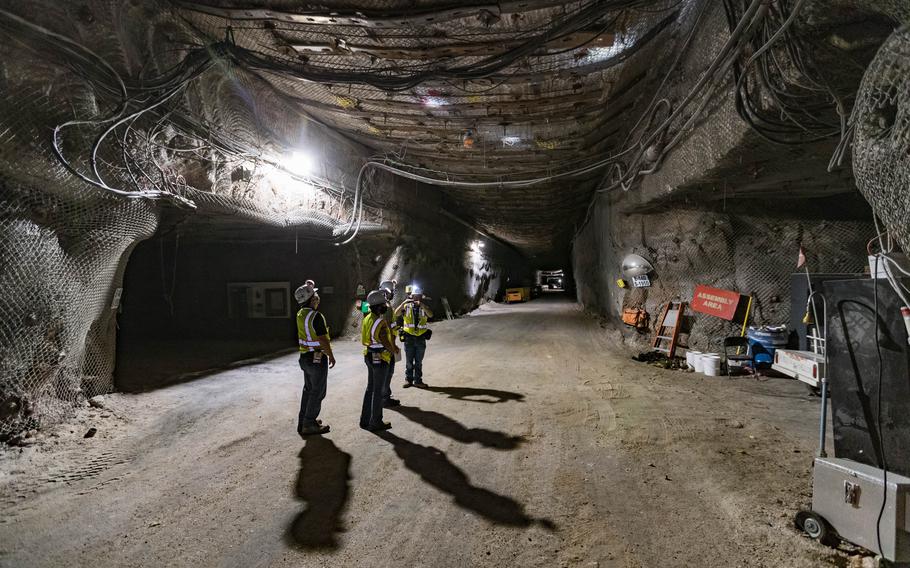
A tour group walks in a geological repository, U.S. Department of Energy’s Waste Isolation Pilot Plant, storing transuranic radioactive waste in the desert between Hobbs and Carlsbad on Aug. 17, 2021 (Nathan J Fish/Sun-News)
(Tribune News Service) — New Mexico’s national laboratories and its repository for nuclear waste - the only of its kind in the nation - received millions of dollars this year via an annual bill that provides funding for national-defense-related facilities across the U.S.
The National Defense Authorization Act (NDAA) was passed by both the U.S. House and Senate and sent to the desk of President Joe Biden to be signed into law.
It will provide federal dollars to military installations and initiatives for Fiscal Year 2022, while setting spending plans and priorities for the next year.
U.S. Sen. Martin Heinrich (D-NM), who sits on the Armed Services Committee in the Senate said this year’s NDAA would benefit his state by providing dollars to New Mexico’s programs, boosting its economy and positioning the state as a “leader” in national defense.
“These provisions, among many others, benefit New Mexico’s economy, and advance our state’s position as a leader in national security for years to come,” Henrich said.
Waste Isolation Pilot Plant
Located near Carlsbad, the Waste Isolation Pilot Plant serves as the nation’s only deep geological repository for nuclear waste.
Low-level transuranic (TRU) waste, consisting of clothing materials and equipment irradiated during nuclear activities, is shipped to WIPP from facilities across the country and buried in a salt deposit about 2,000 feet underground.
The NDAA authorized about $430 million to operated WIPP, including $55 million for construction of WIPP’s ventilation system - part of an about $300 million rebuild known as the Safety Significant Confinement Ventilation System.
Another $25 million in the bill would support ongoing work on a new utility shaft at the facility.
Los Alamos National Laboratory
Los Alamos National Laboratory in Los Alamos serves as a primary facility for U.S. plutonium research and is home to the development of nuclear weapons and other defense-related projects.
The facility has struggled in recent years to comply with calls from the New Mexico Environment Department (NMED) to address groundwater contamination originating from the site.
About $1 billion was provided to LANL by the NDAA to fund its ongoing plutonium research and production of plutonium pits - which are used as the trigger for nuclear weapons.
The dollars supported personnel, equipment and other work at the lab to meet its pit production goals for the next five years - $660 million for plutonium operations and $350 million for pit production.
Of $338 million included in the NDAA for nationwide environmental cleanup, $275 million will go to Los Alamos and another $58 million to its excess, unused facilities.
Sandia National Laboratory
Sandia National Laboratory near Albuquerque also conducts nuclear research and develops technologies for the rest of the nation.
More: Waste Isolation Pilot Plant gets 13K nuclear waste shipments, plans to ‘ramp up’ to 17 a week
It also supports the federal nuclear stockpile through research and modernization efforts.
The lab is managed by the National Nuclear Security Administration, which received $15.9 billion in the bill including funding for Sandia’s engineering, science and system integration programs.
Another $13.8 million was included in the NDAA for a project to develop power sources at the lab.
Radiation exposure
The Radiation Exposure Compensation Act (RECA) was set to expire in 2022, after providing funding to Americans impacted by past radioactive and nuclear projects and suffering health issues from exposure to radiation.
A clause in the NDAA expressed Congress’ desire to continue expanding the RECA beyond next year’s expiration.
In New Mexico, the Trinity Test Site near Alamogordo was where the first nuclear weapons tests were conducted and nearby residents for years claimed they were affected by the radiation released as down winders, despite not be included under such funding.
Uranium workers in New Mexico were included in the RECA for exposure during mining in the northern part of the state, but downwinders in the Tularosa Basin area advocated for to be included.
___
©2021 www.currentargus.com.
Visit currentargus.com.
Distributed by Tribune Content Agency, LLC.